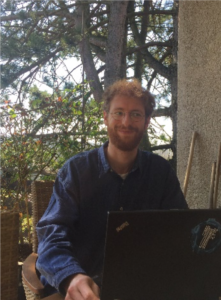Rouven Metz
Hi, my name is Rouven and I’m ESR 10. My research is focused on the rates and mechanisms involved in iron and phosphorus mobilization from vivianite and will investigate the effect of the geochemical environment on this process.
 Before I started my PhD, I obtained my bachelor’s degree in Geoecology and did my thesis about the dissolution of iron minerals in soil under high CO2 concentrations. During my master’s in Environmental Chemistry at University of Bayreuth, Germany, I worked on redox processes in environmental, iron oxidizing biofilms from sub-micro to macro scale. Now, again iron plays an important role during my PhD, since vivianite, the mineral I am working with, is an iron-phosphate mineral.
Before I started my PhD, I obtained my bachelor’s degree in Geoecology and did my thesis about the dissolution of iron minerals in soil under high CO2 concentrations. During my master’s in Environmental Chemistry at University of Bayreuth, Germany, I worked on redox processes in environmental, iron oxidizing biofilms from sub-micro to macro scale. Now, again iron plays an important role during my PhD, since vivianite, the mineral I am working with, is an iron-phosphate mineral.
The iron phosphate vivianite (Fe3(PO4)2∙ 8H2O) occurs worldwide in many reducing environments as e.g. lakes, rivers, swamps, waterlogged soil and sewage sludge and it exists in terrestrial as well as in marine systems. Despite of its widespread occurrence, the importance of vivianite for the burial of P and its role in the global phosphorus cycle might have been underestimated. In recent years, vivianite received more and more attention, on the one hand as remediation product of phosphorus polluted waters, and on the other hand as a valuable resource itself.
 Due to its properties, vivianite is supposed to be an ideal fertilizer:
Due to its properties, vivianite is supposed to be an ideal fertilizer:
-
Vivianite could be a phosphorus recycling product.
-
Vivianite might be a slow releasing fertilizer, resulting in a lower P wash out.
-
Vivianite could serve as phosphorus and iron fertilizer simultaneously.
A few promising investigations have been done by some researchers, applying vivianite as fertilizer. However, a mechanistic understanding of the behavior of vivianite in soil is still missing.
Thus, my research is focused on the rates and mechanisms involved in iron and phosphorus mobilization from vivianite and will investigate the effect of the geochemical environment on this process. The effect of precipitation of secondary minerals will be studied and the effect of naturally occurring iron binding ligands (including low molecular weight organic acids, siderophores, humic substances) on the rates of mineral dissolution will be quantified. State of the art analytical tools will be used as well as geochemical modelling. The project will be performed in close collaboration with the P-Trap partners and involves secondments at academic partners in the consortium (EAWAG and Utrecht University), but also at the company Fertiberia.
My host institution is the University of Vienna with the department of Environmental Geoscience, EDGE. My group gained a lot of knowledge about my favorite element iron. One research field is the mobilization of iron by organisms. Although iron is highly abundant, the biologically available iron is restricted by the low solubility and the slow dissolution kinetics of iron-oxides, in particular at alkaline pH conditions such as calcareous soil. But iron is an essential micronutrient for plants that often limits their growth and reproduction. To cope this, plants exudate protons, reductants and iron-binding ligands to increase iron availability. Based on this knowledge I will have a look on how these processes also influence vivianite.

